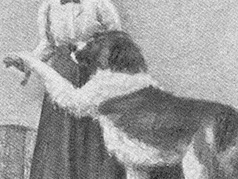The maharaja (prince) of Junagadh, India owned 800 dogs and pampered every one of them.
Each dog had their own room in the lavish palace of the maharaja, and each had their own personal servant. They were often dressed up in formal evening suits so they could go on rickshaw rides around town. The eccentric maharaja would even spend large amounts of money on grand birthday parties. Probably the most extravagant event was the wedding of his favorite dog Roshanara to a royal golden retriever that belonged to the Nawab of Mangrol. Kathleen Walker-Meikle, author of The Dog Book: Dogs of Historical Distinction, described the event:
"Perfumed and in brocade and pearls, Roshanara was brought to the Dubar Hall in a palanquin while Bobby was greeted at the train station by a military band and the maharajah on an elephant with 250 brocade-dressed dogs (also on elephants). The breakfast was attended by 700 guests from Indian princely families, who were entertained by dancing girls singing for the dogs and Mendelsohn's "Wedding March." Alas, the wedding night was interrupted by the majarajah himself, who sent Bobby to the kennels so he could have his beloved Roshanara on his bed as usual."
The dogs also had their own hospital with a British doctor to tend to their ailments. When a dog passed away, a state mourning was declared. Oil portraits of his favorite dogs, including one of the wedding, are still exhibited in Junagadh Palace.




























